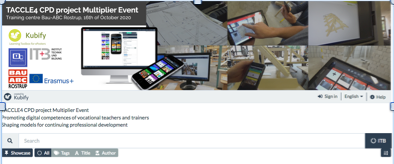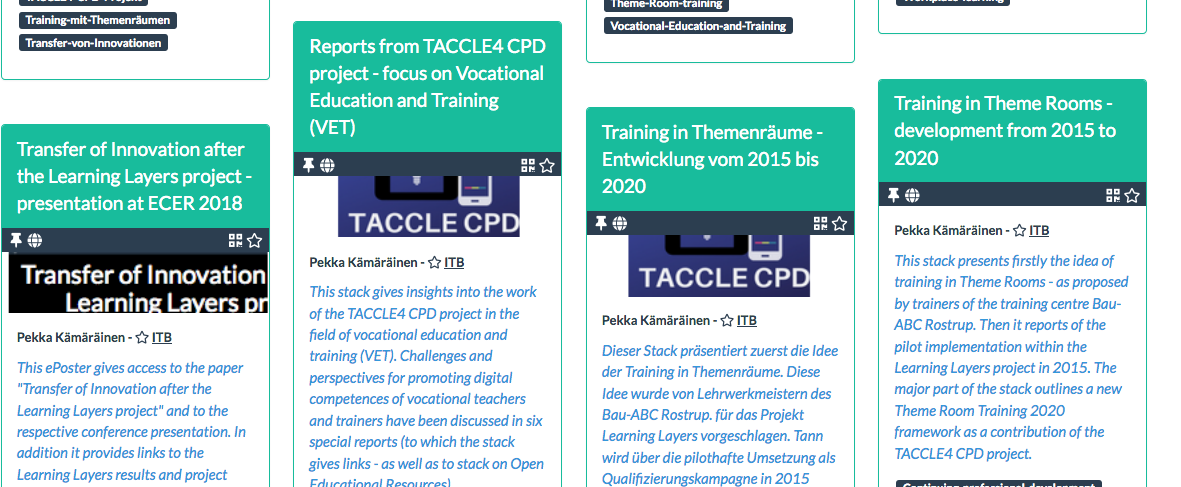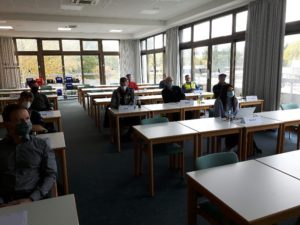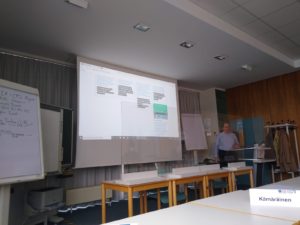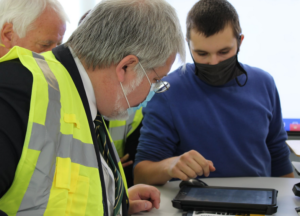Finishing the last reports for TACCLE4 CPD project – Handing over the torch for other runners
During the last few months I have surprised myself by producing three new reports for the ongoing EU-funded TACCLE4 CPD project. As regular readers of this blog will know, the project has been working with strategies for promoting digital competences of teachers and trainers in different educational sectors. And, as a contrast to the three earlier TACCLE projects, the fourth one had the task to shape models and concepts for continuing professional development in educational establishments and training organisations. Furthermore, my role in the project has been to address the task for the field of vocational education and training (VET) and to bring into the project the legacy of the Learning Layers project (in which I had been working for many years).
Now, the project is in its final phase and at the same time my career as an active researchers has come to an end. During the last few weeks I have surprised myself and others by producing three new reports for the project – in addition to the five ones that I had produced by the end of last year. Below, I want to make some comments on these newer reports and how they enrich the group picture of the earlier VET-related reports.
Report 5: Promoting digital competences beyond the accustomed realm of ICT skills
During the project I had been writing blogs on innovative activities to promote digital competences via civic learning and via introduction of specific applications of the Learning Toolbox (the main product developed in the Learning Layers project). To me, the Finnish idea of developing a broad-based introductory course on artificial intelligence (AI) and its impact for the entire civil society was very inspiring. Equally, the recent progress in using the Learning Toolbox (LTB) at different contexts was impressive. In the initial pilot context, vocational trainers made new efforts to support vocational learning during the lockdown. and after the closure period they added new features to using LTB in apprentice training.
Parallel to this, other applications of LTB – mainly the use of LTB to shape ePosters for conferences (that are shifting from face-to-face events into online events) is becoming widespread. Here, it is worthwhile to note the spread from regular conferences into other kinds of of online events – such as multiplier events of EU-funded projects. Furthermore, I got informed of the progress with LTB showcases. Firstly they had been shaped for particular conferences to give a group picture of the ePosters for the respective conference. In a more mature phase the LTB showcase was used to give a group picture of all conferences and online events that were working with ePosters – of which some exemplars were portrayed in this ‘all stars’ showcase. I was happy to give visibility to the start-up company Kubify (founded by the former LTB-developers) due to their latest achievements. Altogether, this report demonstrated the progress of promoting digital competences beyond the accustomed realms of ICT skills.
Activity Report on the German Multiplier Event at the Training Centre Bau-ABC Rostrup
During my working visit in Bremen (after a long break) I had a chance to organise a Multiplier Event that took place as face-to-face event in the training centre Bau-ABC Rostrup (with whom we had worked intensively in the Learning Layers project). For me it was a pleasant opportunity to meet several trainers of the centre – some of which had been our counterparts for years, whilst some were newcomers. In my input I gave an overview, how the co-design processes (that led to to the shaping of the LTB) and the parallel training activities (that were completed with training based on Theme Rooms) worked hand in hand in the Learning Layers project. Then I gave some insights into the idea of different innovation paths (for introducing digital competences in the field of VET) and how they can be addressed in a revisited framework for Theme Room Training 2020. In addition to this I presented the new TACCLE4 CPD Showcase that pulled together the VET-related work in the Learning Layers project and in the current project.
It was interesting to note that the discussion moved on from my inputs to the practical challenges (regarding the use of LTB as support for training) and to the possibilities to take further steps with their internal training. So, in this respect the session became a genuine multiplier event. Indeed, it was concluded with a commitment to start a new round of theme room sessions – based on the ideas and needs of the active trainers and with focus on improving the use of LTB in their context.
Report 2b: The TACCLE4 CPD Showcase as a new collection of online resources
My final report for the project TACCLE4 CPD presented the above-mentioned LTB showcase for this project and how it came into being. As the pre-history I presented the earlier pilot activity to introduce the work with ePosters into the European Conference on Educational Research (ECER) in the year 2018 in Bolzano. This was a limited pilot project with some ePosters for the network program of VETNET (the European Research Network for Vocational Education and Training). As a further step from this phase the report introduced an overarching showcase for the TACCLE4 CPD project. This showcase provided on the one hand comprehensive LTB-stacks thet presented all VET-related reports for the Learning Layers project and for the TACCLE4 CPD project. Then, it introduced thematic stacks that focused ot the use of Open Educational Resources (OER) in the field of VET and outlined the Theme Room Training 2020 framework.
Altogther, this report gave a picture of a new kind of an online resource environment. At the same time it invited the users to consider their own innovation paths and to think of their own ways to shape training with Theme Rooms.
—
I guess this is enough of the latest reports and of the messages I want to pass at the final phase of the project. Now that I am finishing my career as an active researcher, I have the feeling of being a runner with the torch of the Olympic Games. I am coming to the point in which I have to had out the torch for new runners – the ones in research, the ones in the software development and the ones developing their training approaches. My message to them is the following: You need to take the fire from the past, not the ashes. And: You need not go back to the long and winding roads of your predecessors – you need to find each other in the present date circumstances.
More blogs to come … (but from a different perspective)



